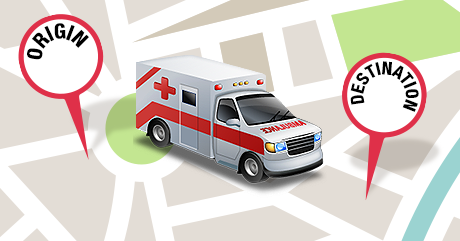Origins and Destinations
Where am I?
We were reminded when adding some new facility locations into our ambulance billing office computer system this week how confusing the types of facilities can become.
Today, a single pick-up and/or drop-off location for an ambulance can serve several capacities. Literally one address, one building even, can house several different functions and purposes where your patients can be treated.
 It is important that the billing office and the EMS providers in the field communicate to pinpoint the exact location of either the point of pick-up or drop-off for your patients.
It is important that the billing office and the EMS providers in the field communicate to pinpoint the exact location of either the point of pick-up or drop-off for your patients.
Origin and Destination Modifiers
Knowing where the patient is located and the locations purpose is important as Medicare, Medicaid and commercial insurance payers require an origin and destination code be applied when billing the resulting ambulance claim for payment. The modifiers are appended in the claim along with the level of service code to denote where the patient transport began and ended.
The choices your billing office have for use are…
D – Diagnostic or therapeutic site (not a doctor’s office or hospital)
E – Residential, domiciliary, custodial facility, nursing other than a Skilled Nursing Facility
G – Hospital based dialysis facility
H – Hospital
I – Site of Transfer (e.g. airport, ferry, helicopter pad) between modes of ambulance transport
J – Non-Hospital based dialysis facility
N – Skilled Nursing Facility (SNF)
P – Physician’s Office/Clinic
R – Residence
S – Scene of Accident or Acute Event
X – Destination Code Only (Intermediate stop at a physician’s office en route to a hospital to stabilize a patient)
The Tricky Part
The tricky part about applying these necessary modifiers comes when it’s not clear what the origin and destination are.
For example, many multi-purpose facilities today have been built to accommodate a wide range of residents. It’s not uncommon to have one facility at one central address contain separate parts with varying housing types.
XYZ Senior Living may have a SNF wing, another wing that is assisted living and yet a third area as part on the same physical grounds with the same address that is independent living for senior residents. So, when you treat and transport to and from this one location, somehow you must communicate in the Patient Care Report (PCR) exactly the location of the patient within that common facility location.
It’s simple but we EMS providers often forget the confusion that can arise resulting in the application of the wrong modifier by the billing office staff.
Your PCR should read something like…
“Arrived on scene at 123 Anywhere St., XYZ Senior Living, assisted living area to find…”
The same thing can happen with large hospitals (or even small ones) with various dedicated floors for multiple purposes. Doctor’s offices can be housed on one floor while the inpatient area is located on another floor. Just because the physician’s office happens to be on the third floor of the hospital, does not mean that your billing office can use the hospital modifier when billing, as that modifier is reserved for the inpatient or emergency department of the facility.
The same goes for inpatient dialysis areas that are inside of a hospital. It’s not enough to document that you transported the patient to or from the hospital address location, if the patient’s origin or destination is the dialysis part which you’ll see above calls for its own unique modifier.
Communicate and Plan Ahead!
It’s important to discuss these situations whenever your operations and billing staff get communicate. Put a plan in motion so the billing office clearly knows what the origin and destination of the patient is. Determine how EMS providers are to refer to certain locations in their PCRs ahead of time so there is no confusion.
EMS field providers should constantly communicate back to the billing office regarding new facilities and/or changes made within existing facilities in your coverage area.
Communication is the key to properly applying the correct modifier!